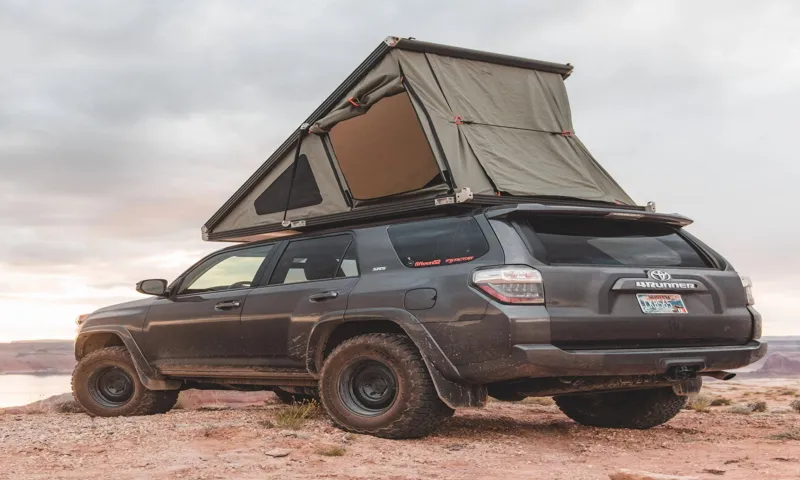Are roof top tents warm? If you love exploring the great outdoors and going on camping trips, then this is a question that might have crossed your mind. After all, who wants to freeze in their tent when the temperature drops during the night? Luckily, roof top tents have become increasingly popular among campers, hikers, and adventure enthusiasts for many reasons, one of which is their ability to provide warmth and comfort even in colder weather. These tents are designed to be mounted on top of your vehicle, providing a raised platform that keeps you off the ground and away from any potential dampness or cold.
But how do roof top tents actually ensure a cozy and warm sleeping experience? The secret lies in their construction and insulation. Most roof top tents are made with durable and high-quality materials that can withstand various weather conditions. They often have a waterproof and windproof outer layer, along with a thick layer of insulation to trap and retain heat.
In addition to their insulation, roof top tents also feature a closeable entrance and windows, allowing you to regulate the airflow and keep the warmth inside. This means you can adjust the ventilation to your liking and create a comfortable environment inside the tent, regardless of the external weather conditions. Furthermore, some roof top tents come equipped with features like built-in heaters or heating systems that can be powered by your vehicle’s battery.
These additional heating options are perfect for those extremely cold nights when you need some extra warmth to make your camping experience enjoyable and cozy. So, if you’re worried about staying warm during your camping trips, roof top tents are definitely a great choice. With their insulation, ventilation options, and even built-in heaters, these tents can provide a cozy haven for you to escape the cold and enjoy a good night’s sleep.
Whether you’re camping in the mountains, by the beach, or in the woods, a roof top tent will keep you warm and comfortable, allowing you to fully embrace the beauty of the great outdoors.
Table of Contents
How Insulation Works in Roof Top Tents
When it comes to staying warm in a roof top tent, insulation is key. Insulation works by trapping air in small pockets, creating a barrier between the inside and outside temperatures. This helps to regulate the temperature inside the tent, keeping it warm in colder weather and cool in hotter weather.
It acts as a barrier against the elements, preventing heat loss or gain. In roof top tents, insulation is typically found in the walls and roof of the tent. The materials used for insulation can vary, but common options include foam or synthetic fibers.
By choosing a roof top tent with good insulation, you can ensure a comfortable and cozy camping experience, no matter the weather outside. So, when you’re considering a roof top tent, don’t forget to think about how well it is insulated to keep you warm during your outdoor adventures.
The Importance of Insulation in Roof Top Tents
insulation in roof top tents, importance of insulation in roof top tents

Types of Insulation Used in Roof Top Tents
In roof top tents, insulation is crucial for regulating temperature and creating a comfortable sleeping environment. Insulation works by minimizing the transfer of heat, helping to keep the interior of the tent warm in cold weather and cool in hot weather. There are different types of insulation used in roof top tents, including foam, felt, and reflective materials.
Foam insulation is often used for its excellent thermal properties and ability to reduce noise. Felt insulation is another popular choice, as it is lightweight and provides good insulation against both heat and cold. Reflective insulation is designed to reflect heat away from the tent, keeping the interior cooler during hot weather.
No matter which type of insulation is used, it plays a critical role in ensuring that roof top tent users stay comfortable, no matter the outside temperature.
Factors Affecting Warmth in Roof Top Tents
One of the biggest factors affecting the warmth in roof top tents is the insulation. Roof top tents are typically made with durable materials that can withstand outdoor elements, but they may not always provide the best insulation. This means that during colder months, the tent may not retain heat very well, resulting in a chilly sleeping environment.
However, there are ways to improve the warmth in roof top tents. Some tents come with optional insulation layers that can be added to the interior walls of the tent, providing an extra barrier against the cold. Additionally, using a good quality sleeping bag and a thick mattress or sleeping pad can help to insulate your body from the cold ground.
Investing in a tent heater or using hot water bottles can also provide some additional warmth. Overall, while roof top tents may not be as warm as traditional tents, with the right precautions and equipment, you can still enjoy a comfortable and cozy sleep. So, if you are planning to go camping during colder months, it’s important to take these factors into consideration and make the necessary arrangements to ensure a warm and enjoyable camping experience.
Material of the Tent Fabric
Factors Affecting Warmth in Roof Top Tents
Weather Conditions
factors affecting warmth in roof top tents. When camping in a roof top tent, staying warm and comfortable is essential for a good night’s sleep. There are several factors that can affect the warmth inside a roof top tent.
One of the main factors is the weather conditions. If you’re camping in a cold and windy environment, the tent will be exposed to the elements, and it can be challenging to keep the interior warm. In such cases, investing in a high-quality tent with good insulation is crucial.
Look for tents that have thick walls and high-quality fabrics that can trap heat inside. Additionally, using a good-quality sleeping bag and thermal blankets can help to keep you warm throughout the night. Another factor to consider is the ventilation inside the tent.
While it’s important to have proper airflow to prevent condensation, too much ventilation can cause drafts and make the tent feel colder. Finding the right balance between ventilation and warmth is key. Finally, consider the insulation underneath the roof top tent.
Using a thick camping mat or a foam pad can provide additional insulation and help to keep the cold ground from seeping into the tent. By considering these factors and being prepared for the weather conditions, you can ensure a cozy and warm camping experience in your roof top tent.
Proximity to the Vehicle
roof top tents, warmth, proximity, factors
Tips for Keeping Warm in a Roof Top Tent
Roof top tents are a great way to experience camping in a unique and adventurous way. However, one concern that many people have is whether or not they will be warm enough during cold nights. Thankfully, there are several tips and tricks for keeping warm in a roof top tent.
First and foremost, it’s important to have a good quality sleeping bag that is rated for the temperature you expect to encounter. Layering your clothing is also crucial, as it allows you to add or remove layers depending on the temperature. Additionally, using a thermal blanket or insulation mat underneath your sleeping bag can help to provide extra warmth.
Finally, using a tent heater or hot water bottle can also make a big difference in keeping you warm throughout the night. So, while roof top tents may require a bit more thought and preparation to stay warm, with the right gear and strategies, you can have a cozy and comfortable camping experience.
Using Appropriate Bedding
“rooftop tent bedding” As the nights start to get colder, there’s nothing worse than trying to sleep in a cold rooftop tent. But fear not, there are ways to keep warm and cozy in your elevated abode. One of the key factors in staying warm is using appropriate bedding.
Opt for a thermal sleeping bag that is designed for colder temperatures. Look for sleeping bags with a lower temperature rating, as these are specifically made to keep you warm in chilly conditions. Additionally, consider using a mattress pad or foam mattress to provide insulation between you and the cold air beneath you.
This extra layer will help to keep your body heat from seeping into the ground. Lastly, don’t forget about your pillow. Look for one with insulation properties or consider using a small heated pillow to keep your head and neck warm during the night.
With the right bedding, you’ll be able to stay warm and comfortable in your rooftop tent, no matter how chilly it gets outside.
Ventilation and Condensation Management
Ventilation is an important aspect to consider when using a roof top tent, especially in colder weather. One tip for keeping warm in a roof top tent is to ensure proper ventilation to prevent condensation buildup inside the tent. Condensation occurs when warm air inside the tent comes into contact with the cold surface of the tent walls, causing moisture to form.
This can lead to a damp and uncomfortable environment, making it difficult to stay warm. To avoid this, it is important to keep air circulating by opening windows or vents in the tent. This allows fresh air to enter and stale air to exit, reducing the chances of condensation.
Additionally, using a dehumidifier or moisture-absorbing products can help control excess moisture. By maintaining proper ventilation and managing condensation, you can stay warm and comfortable in your roof top tent even in colder temperatures.
Conclusion
So, are rooftop tents warm? Well, let’s be honest here – they’re not exactly the Ritz Carlton. But hey, if you’re someone who likes to feel the breeze in your hair and the stars on your face, then a rooftop tent might just be for you. Think of it as camping in the treehouse of your dreams – cozy, slightly rustic, and just a tad bit adventurous.
So embrace the cold nights and snuggle up in your rooftop tent, because it’s not just about the warmth, it’s about the experience. Happy camping!”
FAQs
Are roof top tents warm in cold weather?
Yes, roof top tents are designed to be warm in cold weather. They are typically equipped with insulation and heavy-duty materials that help retain heat and keep you comfortable even in low temperatures.
Can I use a roof top tent in the winter?
Absolutely! Many roof top tents are specifically designed for year-round use, including winter camping. With the right insulation and heating setups, you can stay warm and cozy inside your roof top tent even in the coldest of winter conditions.
How do roof top tents stay warm in cold weather?
Roof top tents stay warm in cold weather through various means. Insulating materials such as foam or quilted walls, floors, and ceiling help to retain heat inside the tent. Additionally, some roof top tents have optional accessories like portable heaters or heated mattress pads that provide extra warmth.
Are roof top tents warmer than traditional ground tents?
Generally, roof top tents are considered to be warmer than traditional ground tents. Their elevated position reduces heat loss through the ground and helps maintain a more consistent internal temperature. Additionally, the insulation and weatherproofing of many roof top tents provide better protection against cold weather.
Are there any special considerations for using a roof top tent in cold weather?
When using a roof top tent in cold weather, it is important to properly insulate the bottom of the tent to prevent heat loss through the roof of your vehicle. This can be done with a thermal barrier or an insulating layer like a rubber mat. It is also advisable to use a winter-rated sleeping bag and wear appropriate clothing to stay warm during the night.
Can I use a roof top tent in extremely cold temperatures?
While roof top tents are designed to withstand cold temperatures, there are limits to their effectiveness in extreme conditions. It is recommended to consult the manufacturer’s guidelines for temperature ratings and consider using additional insulation or heating devices if camping in extremely cold temperatures.
Are there any additional accessories or gear I should consider for cold weather camping in a roof top tent?
Yes, there are several accessories and gear that can enhance your cold weather camping experience in a roof top tent. These include portable heaters, heated sleeping pads or blankets, thermal curtains or covers for the tent windows, and insulating layers for the floor and roof of the tent.



